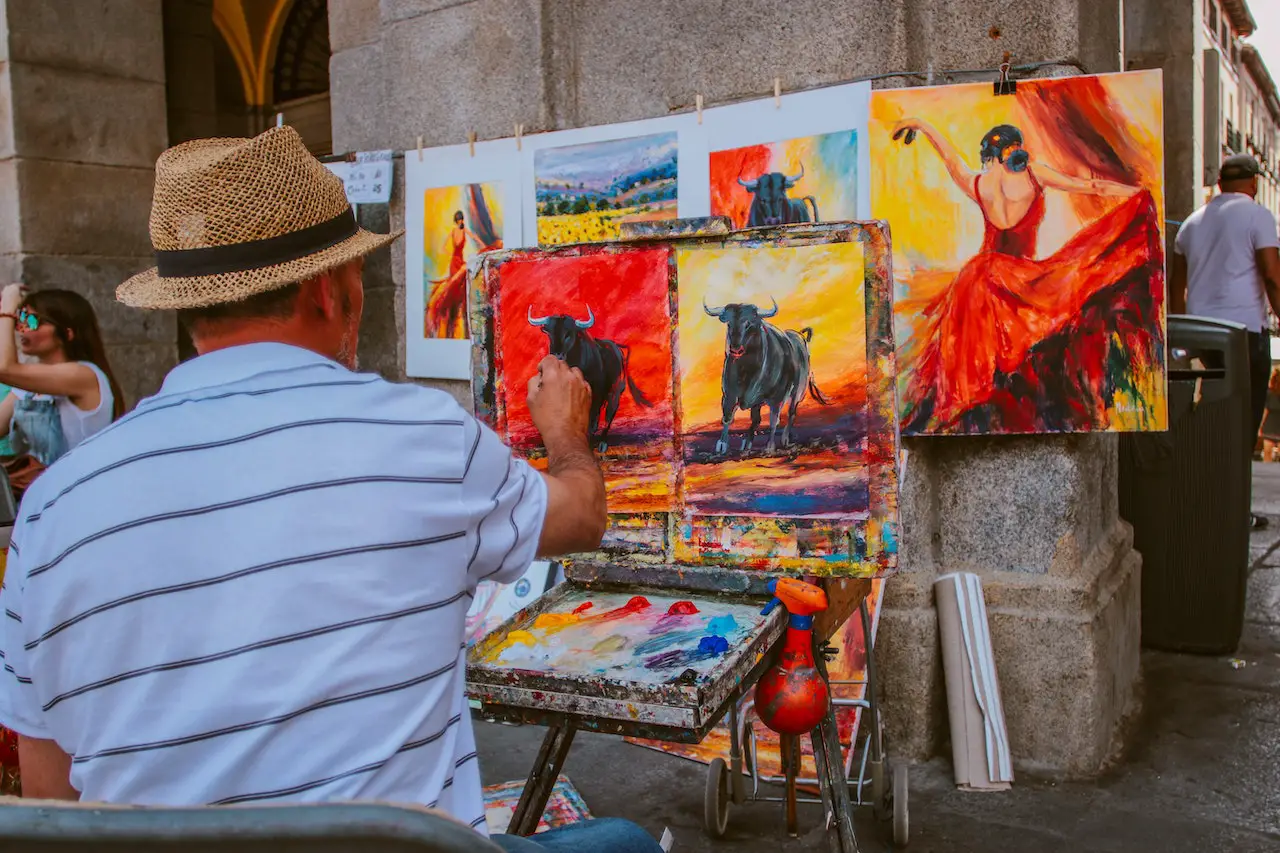Have someone got interested in your painting and they want to buy it? As many of us started painting as a hobby, we may completely forget the pricing. However, it is important to price your artwork properly so that you can sustain your hobby or even the art business. So, let’s see how much acrylic paintings are worth.
In general, the acrylic painting of a beginner artist can range from 15 USD to 1000 USD while more established artists value their paintings at even 10,000 USD. The value of an acrylic painting varies based on the size, complexity, quality of materials, artist’s reputation, and market demand.
Problems artists face while pricing their artwork include underestimating the value of their time and skill, not considering the cost of materials and overhead, and not researching comparable artwork by other artists. This article will help address all the important points that you need to consider when pricing your artwork.
How much are acrylic paintings worth?
In general, acrylic paintings may be worth between $15 to $ 10 000. Prices can generally increase with the painting size, the subject matter, the complexity of the work, the selling location, and the track record of the artist. Many beginner artists undercharge for their paintings, to the point it does not cover the costs.
It is common for beginner artists to need help with pricing their acrylic paintings. Pricing artwork can be challenging because it involves considering several factors, such as the complexity of the artwork, the materials used, time spent on the painting, the artist’s experience and reputation, and the current market demand for similar works.
I have noticed that many beginner artists sell their work for less than its actual value, especially if they are unfamiliar with the market and pricing. It is important to remember that a beginner’s painting can be as valuable as an expert in the field. The value depends on the art itself and the one who is looking for the art.
7 Top Tips on pricing acrylic paintings
There are many factors you need to consider when pricing your artwork. Ultimately your price needs to pay for your costs, overhead, and time. If not your art business might not be sustainable. Below are 7 top tips to price artwork the best.
1. Be consistent with your pricing
It is important to be consistent when pricing your artwork. The easiest way to do that is through size-based pricing. The price of a painting needs to go up as the size of the painting increases. This will make sure a larger painting is usually priced higher than a smaller painting. This will make your pricing consistent in the eyes of your customers.
Also, it is important to note that you can go up on the pricing of your paintings but never down. It is a good rule of thumb to increase your pricing each year by $0.25 per square inch if you are a beginner and $3 if you are an expert or if it has been a good year for you.
However, dropping prices from a higher price will badly impact your reputation. Especially the customers who bought your paintings earlier will feel bad as similar artworks are now sold for a lesser price.
Another important factor that you need to consider when pricing artwork is supply and demand. If there is a higher demand, and it is harder for you to produce to meet the demand, it is a good time to raise your prices. This way you can make the same amount of money by painting less.
2. Pick a price that fits in your locality
One of the important factors that you need to take into consideration is the location where you are established. It is important to price your paintings to suit your locality. As an example, a painting would sell for a higher price in New York city but not as much in a suburban area of the USA.
Before pricing your artwork look into the pricing of similar paintings like yours in your locality or with the same customer base as yours. identify the range of prices and place the price of your artwork at a middle point. It should not be too low or too high. Place the pricing competitively. If you place a slightly lower price than a similar artwork, you stand a better chance of getting sold.

If there is not much artwork in your local areas, you can look into the neighborhoods or even closeby regions to find similar artwork. Especially see the artwork of your nature, similar style, similar subject matter, similar quality level, experience, and of course a similar paint medium, which is acrylic paint.
It is also a very good idea to connect with art groups in your local area and go to art shows and art exhibitions. When you go to art shows, make note of the paintings and their prices, you may also snap some photos of the paintings at the art show.
3. Factor the size of the painting into the pricing
Size-based pricing is one of the best methods of determining the price. It relates best with customers and they can understand it well. In this method, a larger acrylic painting will be valued more than a smaller one.
The two popular methods of size-based pricing are either the square inch (h x w) method or the linear inch (h + w) method. These methods will ensure consistent pricing of your artwork. These methods may be looked at as bold by artists but I believe they are a great starting point.
Even though these methods spit out an exact price for an artwork according to its size, you can do slight adjustments as there are more details and complexity in a painting.
Square inch pricing
Square-inch pricing takes the height (h) and width (w) of the painting and multiplies it by the price you give for a square inch (r).
- The formula is h x w x r = price.
Here are some example canvas sizes using square inch pricing, using a multiplier of $ 2 per square inch.
- 4×4 inches = 16 square inches x $ 2 = $ 32
- 8×8 inches = 64 square inches x $ 2 = $ 128
- 16×16 inches = 256 square inches x $ 2 = $ 512
- 24×24 inches = 576 square inches x $ 2 = $ 1152
The multiplier (r) can be changed according to your skill level or the quality of the artwork. Below is a chart you can use for square-inch pricing along with different multipliers. As you can see there is a drastic change in prices with increasing size.
The multipliers in the chart might be lower considering the cost and the similar artwork prices. Therefore before jumping the gun with size-based pricing check if the cost and related artwork prices tally with that.
Linear-inch pricing
Linear-inch pricing adds the painting’s height and width and then multiples it with an appropriate reputation factor. Linear-inch pricing is best if you want a more leveled and gradually increasing pricing scheme according to size.
- The formula is (h + w) x r = price.
Here are the same example sizes using linear inch pricing, using a multiplier (r) of $ 5.00 per linear inch.
- 4+4 inches = 8 linear inches x 5 = $ 40
- 8+8 inches = 16 linear inches x 5 = $ 80
- 16+16 inches = 32 linear inches x 5 = $ 160
- 24+24 inches = 48 linear inches x 5 = $ 240
I prefer the linear inch method as there are no drastic changes in price as the size increases.
4. Factor your expertise in the field into the pricing
You can change the multiplier (r) in square inch or linear inch methods depending on your experience and reputation in the art industry. The higher your expertise and reputation get, the higher the multiplier you can use.
However, in general, it is best to set the multiplier(r) to $ 2 per square inch, as the base for new artists and those trying to break into the market. Famous and established artists that are in high demand can use a higher multiplier and can expect a higher commission.
If you are a new artist try to build a track record of art sales or volume of sales before thinking about increasing your prices.
Tip: Only put your best work out into the world, with their true prices. You can gift or sell artwork that is not the best for a lower price to your friends and family.
5. Your pricing should cover the labor cost and material cost
The prices you put on paintings need to cover at least the cost of materials, as well as pay for your labor. This way you can continue painting, buy new supplies, and pay for your time, making art a sustainable career or a business.
According to U. S. Bureau of Labor Statistics, Fine Artists, Including Painters, Sculptors, and Illustrators make a mean hourly wage of $ 33.18 (source). However, the hourly wage also changes depending on the artist’s location in states with the highest employment level in Fine Artists, Including Painters, Sculptors, and Illustrators as follows;
| State | Hourly mean wage | Annual mean wage |
|---|---|---|
| California | $ 31.57 | $ 65,660 |
| Texas | $ 13.10 | $ 27,250 |
| Georgia | $ 30.52 | $ 63,480 |
| Florida | $ 26.51 | $ 55,150 |
| Ohio | $ 19.82 | $ 41,230 |
You can use these hourly wage rates in different states to determine your hourly rate. See how each state has a unique hourly rate. Therefore it is important to find out the mean hourly rate of an artist who is doing a similar type of artwork as you are. You can check the hourly rate for your particular state here.
In the chart, you will see that California has the highest hourly rate for fine artists where as Texas pays the least hourly wage for a fine artist. Make sure to pay yourself a good hourly rate.
Now that we know our hourly rate, it is time to figure out how much it cost for materials to produce an artwork. In terms of materials, it is always best to use high-quality items that ensure longevity such as linen canvas, lightfast pigments of high-quality paints, and heavy-duty stretcher bars if you are stretching your canvas.
If you are interested in a price breakdown of acrylic paint on the market you can read my article; Are acrylic paints expensive? (a price breakdown).
The canvas of 16 * 10 might have cost you $10 and for the paint, it might be $ 10. So the total cost of materials will be $ 20. Now, you can add the material cost to the cost of labor and check if your artwork price covers that.
If the creation of the artwork takes 5 hours, and your hourly wage is $ 20 per hour, the final price of the artwork would be;
- $20 multiplied by 5 hours + $20 for the materials= $120
Now, make sure to add any other overhead costs or cost of shipping, nameplate cost, or framing costs to this price. If you are adding a frame or a nameplate doubling its original price and adding, is a good rule of thumb.
- $ 5 for overhead + $ 120 = $ 125 (cost of producing acrylic painting)
Now the price you sell the artwork needs to be more than $ 125 to make a gross profit. This will make money to pay for any business expenses. So the final price can be around $ 200. Check if you get similar pricing with the size-based pricing methods.
According to the linear inch method, 16 * 10 canvas art will be;
16 + 10 = 26 * $ 8 = $ 208
To get to at least $ 208 for your painting, the multiplier (r) needs to be about $ 8.
6. More detailed paintings can be priced higher
Using only an hourly rate to determine the price of your painting can be bizarre. This is because it may take more time to complete a painting as a beginner, but you will be able to complete the same painting quickly as you get more experienced. trial and error So it will be unfair to charge more because you are a slow beginner.
However, if the painting is more comprehensive, detailed, and more time-consuming for even an experienced artist, it is okay to take time spent on painting as a pricing factor. This means you need to determine how comprehensive your painting is and take that into account when pricing artwork.
Also, if your painting is based on a good source photo with a beautiful subject matter, composition, and lighting that appeals to the buyer, your painting can be priced higher. Therefore always aim to find the best source photo for your artwork.
Furthermore, as a beginner, we all start with some painting tutorials. But the original artwork is of someone else’s. Therefore the price of our version of the painting will be priced lower. Because of this, it is best to learn to produce original artwork as soon as possible to have a competitive pricing scheme.
7. Let the art gallery decide the price
If you are planning to display your artwork at an art gallery, you will have to agree to gallery prices. These will be double the original price of your artwork as the gallery also keeps a cut of it.

The type of Gallery you display your artwork will determine the painting price. If it is a prestigious gallery with high-end market value, your painting might be worth a few thousand dollars. But if it is a small town gallery your painting may be worth only a few hundred dollars.
However, never sell the same painting in your studio for less than the gallery price if the customer founds your artwork at the gallery and came for you at the studio. The best you can do is provide a smaller discount of like 10% to that customer and then inform the gallery about it.
Are acrylic paintings less valuable than oil paintings?
Although oil paintings can be more expensive and seen as having greater value than acrylic paintings, the true value of a painting is not solely determined by the medium used. Rather a value of a painting is determined by factors such as the artist’s popularity, the scale of the painting, its quality, the historical significance, and the demand among collectors.
Some art collectors may prefer oil paintings over acrylic paintings, but that does not necessarily make oil paintings inherently more valuable. On the other hand, some artists and art lovers may appreciate the unique qualities and versatility of acrylics, which can dry more quickly and be more easily manipulated than oils.
Ultimately, the value of a painting is subjective and can vary greatly depending on the context. There are many highly valued acrylic paintings and many oil paintings of little value, so it is not accurate to make a blanket statement about the relative importance of these two mediums.
Although you might think that the look of oil paintings cannot be created with acrylic paints, it is not necessarily true. There are different mediums you can use with acrylic paints such as the glazing medium that helps to create silky smooth thin layers of paint. Almost any look is possible with acrylic paint and it is more convenient too, Thus acrylic paintings can be as valuable as oil paintings.
According to the Marshall Gallery, canvas oil paintings can range anywhere from $100 for a small, simple oil painting of an unknown artist to more than $1000 for a larger more complex painting or a painting of a well-known artist. According to the square-inch pricing method, a smaller, acrylic painting of an unknown artist can start at $10 whereas a larger acrylic painting of a professional artist can be more than $2000.
As you can see there is a wider range of prices for acrylic paintings, even though oil painting prices start at a slightly higher level.
Where to sell acrylic paintings?
There are many opportunities and places to sell your artwork nowadays. With a little research, you can pick the best one for you. Below I have provided details on some of the places and platforms you can start selling your artwork.
Tip: Only showcase your best work to the public. It helps you to keep your art history at a higher level and will make demanding your artwork easier.
I have written a whole article about ‘15 Best Places to Sell Acrylic Paintings with Top Tips‘. There I have explained in detail about both online and offline venues for you to sell acrylic paintings and stand a better chance of getting sold.
Showcase your artwork on the web
Create a website or online portfolio to display your work and establish your identity. Develop a consistent aesthetic for your paintings. Use social media sites like Instagram, FaceBook YouTube, and TikTok to publicize your artwork and reach a larger audience.
Participate in exhibitions to network with customers
Participate in regional art fairs and exhibitions to showcase your work in person and network with possible customers. You can also network with other artists and galleries, which might result in further business chances.

Use online art platforms to sell your paintings
Saatchi Art, Artsy, Etsy, and even eBay are a few online art marketplaces where you can sell your artwork on. They let artists sell their creations directly to customers. These platforms give you access to an interested audience and make it simple for customers to buy your artwork.
Collaborate with regional galleries
Consider working with regional galleries to exhibit and sell your work. Using this approach, you can expand your audience and enhance your artistic reputation. Having your art displayed at galleries will make interesting track records as an artist.
Obtain criticism and keep improving…
To enhance your work and increase the likelihood that your paintings will sell, seek helpful critiques from friends, family, and other artists. Find what works best for you by experimenting with various methods. It takes time and effort to sell your artwork, but the satisfaction of having someone value and purchase it is priceless.
Conclusion
Most artists seem to make less from sales than they did from the original investment. Keeping track of your costs and the time spent producing the artwork is a good approach when pricing artwork. Remember to include your direct material costs and overhead costs, like studio rent, utilities, etc in pricing as well. However, beginner artists need to understand the importance of their work so they can price it appropriately.

